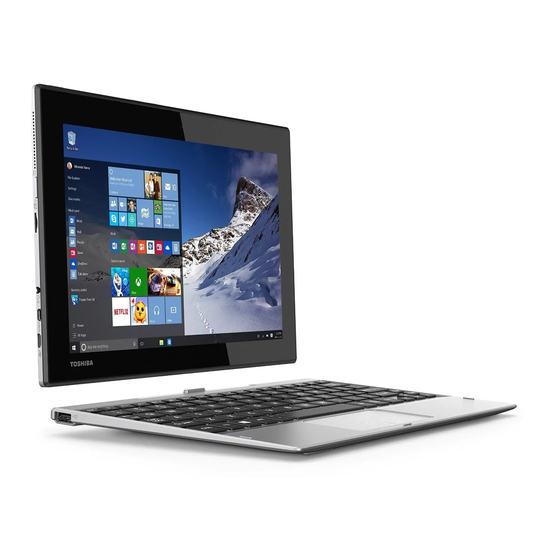
Table of Contents
Advertisement
Quick Links
User's Manual
Satellite Click LX0W-C/Satellite
Click LX5W-C/Satellite Click10
LX0W-C/ Satellite Click10 LX5W-C
Encore LX0-C/Encore LX5-C/Encore 10
LX0-C/Encore 10 LX5-C LX0W-C/
LX5W-C/LX0-C/LX5-C
dynabook N40
dynabook NB40
dynabook S60
N40
NB40
S60
Encore 10K LX0W-C
Encore 10K LX5W-C
Satellite Click 10/Encore 10 series
(Docking only)
Keyboard Dock PA5240*-****
(Docking only)
キーボードドック PA5240*-****(Docking only)
Advertisement
Table of Contents

Summarization of Contents
TOSHIBA Legal, Regulatory, and Safety
Copyright, Disclaimer and Trademarks
Manual content copyright, usage terms, and trademark acknowledgments.
Regulatory Information
Details CE marking compliance and European directives applicable to the product.
General Precautions
Lists essential safety measures for operating the computer to prevent injury or damage.
Getting Started
Equipment checklist
Verifies all included hardware and documentation items are present before setup.
Dual Operating Mode
Explains the computer's versatility between tablet and laptop operational modes.
Using your computer for the first time
Guides users through initial computer setup, power connection, and OS installation.
Turning off the power
Details the correct procedures for shutting down the computer safely.
The Grand Tour
The Computer (tablet mode)
Identifies key physical components and ports of the computer in tablet form.
The Computer (laptop mode)
Identifies key physical components and ports of the computer in laptop form.
TOSHIBA Keyboard Dock
Describes the features and connection interface of the keyboard dock.
Internal Hardware Components
Provides an overview of the computer's internal hardware specifications.
Operating Basics
Operating in tablet mode
Instructions and precautions for using the computer while in tablet mode.
Using the Touch Screen
Explains touch gestures like tap, press & hold, pinch/stretch for interaction.
Using the Touch Pad
Details touch pad gestures such as tap, two-finger tap, and scrolling.
The Keyboard
Covers keyboard layout, function keys, and special Windows keys.
Battery
Explains battery usage, charging, care, and capacity monitoring.
External Display
Guides on connecting and configuring external monitors or TVs.
Utilities and Advanced Usage
Utilities and Applications
Introduces pre-installed software utilities and their basic functions.
TOSHIBA Setup Utility
Guides on accessing and using the BIOS setup for system configuration.
System Recovery
Details procedures for creating recovery media and restoring the system.
Troubleshooting
Problem-solving process
Provides a structured approach to diagnosing and resolving computer issues.
Analyzing the problem
Offers key questions to ask when troubleshooting software or hardware faults.
Hardware and system checklist
Lists common hardware components and peripherals for troubleshooting.
Power
Addresses issues related to the computer not powering on or overheating.
Keyboard
Guides on troubleshooting keyboard input or display output problems.
Touch Pad
Provides solutions for issues with the touch pad not working or responding incorrectly.
Sound system
Offers steps to resolve no sound or annoying audio issues.
TOSHIBA support
Directs users on how to obtain technical assistance from TOSHIBA.
Appendix
Specifications
Summarizes key technical details like dimensions, environmental, and power requirements.
AC Power Cord and Connectors
Details specifications and certification for power cords and plugs.
Information for Wireless Devices
Covers wireless technology interoperability standards and health considerations.
Radio Regulatory Information
Outlines radio frequency usage restrictions and compliance in various regions.
CPU
Explains legal footnotes regarding CPU performance variations and conditions.
Memory (Main System)
Discusses main system memory usage, limitations, and 64-bit computing.
Battery Life
Details factors influencing battery life and replacement information.












Need help?
Do you have a question about the Satellite Click LX5W-C and is the answer not in the manual?
Questions and answers